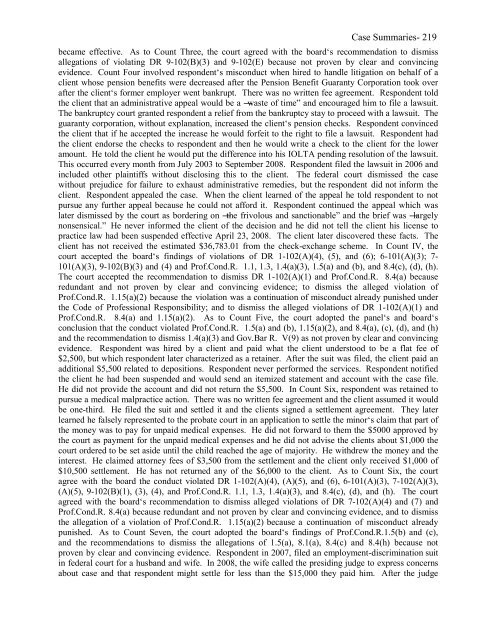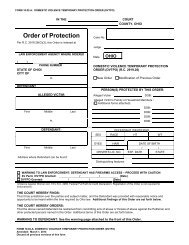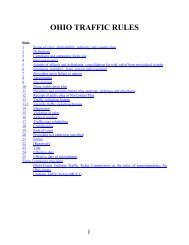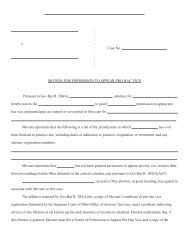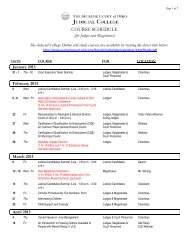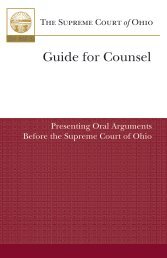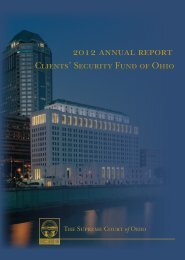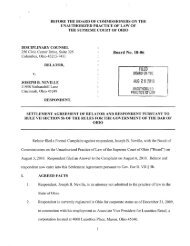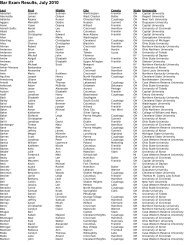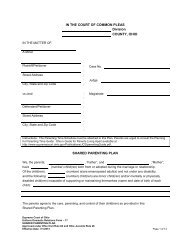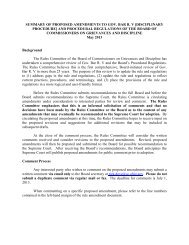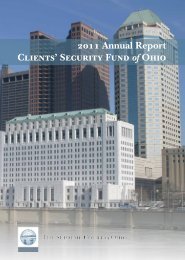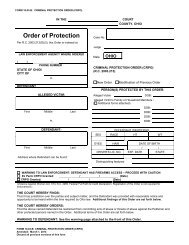disciplinary handbook: volume v - Supreme Court - State of Ohio
disciplinary handbook: volume v - Supreme Court - State of Ohio
disciplinary handbook: volume v - Supreme Court - State of Ohio
Create successful ePaper yourself
Turn your PDF publications into a flip-book with our unique Google optimized e-Paper software.
Case Summaries- 219became effective. As to Count Three, the court agreed with the board‘s recommendation to dismissallegations <strong>of</strong> violating DR 9-102(B)(3) and 9-102(E) because not proven by clear and convincingevidence. Count Four involved respondent‘s misconduct when hired to handle litigation on behalf <strong>of</strong> aclient whose pension benefits were decreased after the Pension Benefit Guaranty Corporation took overafter the client‘s former employer went bankrupt. There was no written fee agreement. Respondent toldthe client that an administrative appeal would be a ―waste <strong>of</strong> time‖ and encouraged him to file a lawsuit.The bankruptcy court granted respondent a relief from the bankruptcy stay to proceed with a lawsuit. Theguaranty corporation, without explanation, increased the client‘s pension checks. Respondent convincedthe client that if he accepted the increase he would forfeit to the right to file a lawsuit. Respondent hadthe client endorse the checks to respondent and then he would write a check to the client for the loweramount. He told the client he would put the difference into his IOLTA pending resolution <strong>of</strong> the lawsuit.This occurred every month from July 2003 to September 2008. Respondent filed the lawsuit in 2006 andincluded other plaintiffs without disclosing this to the client. The federal court dismissed the casewithout prejudice for failure to exhaust administrative remedies, but the respondent did not inform theclient. Respondent appealed the case. When the client learned <strong>of</strong> the appeal he told respondent to notpursue any further appeal because he could not afford it. Respondent continued the appeal which waslater dismissed by the court as bordering on ―the frivolous and sanctionable‖ and the brief was ―largelynonsensical.‖ He never informed the client <strong>of</strong> the decision and he did not tell the client his license topractice law had been suspended effective April 23, 2008. The client later discovered these facts. Theclient has not received the estimated $36,783.01 from the check-exchange scheme. In Count IV, thecourt accepted the board‘s findings <strong>of</strong> violations <strong>of</strong> DR 1-102(A)(4), (5), and (6); 6-101(A)(3); 7-101(A)(3), 9-102(B)(3) and (4) and Pr<strong>of</strong>.Cond.R. 1.1, 1.3, 1.4(a)(3), 1.5(a) and (b), and 8.4(c), (d), (h).The court accepted the recommendation to dismiss DR 1-102(A)(1) and Pr<strong>of</strong>.Cond.R. 8.4(a) becauseredundant and not proven by clear and convincing evidence; to dismiss the alleged violation <strong>of</strong>Pr<strong>of</strong>.Cond.R. 1.15(a)(2) because the violation was a continuation <strong>of</strong> misconduct already punished underthe Code <strong>of</strong> Pr<strong>of</strong>essional Responsibility; and to dismiss the alleged violations <strong>of</strong> DR 1-102(A)(1) andPr<strong>of</strong>.Cond.R. 8.4(a) and 1.15(a)(2). As to Count Five, the court adopted the panel‘s and board‘sconclusion that the conduct violated Pr<strong>of</strong>.Cond.R. 1.5(a) and (b), 1.15(a)(2), and 8.4(a), (c), (d), and (h)and the recommendation to dismiss 1.4(a)(3) and Gov.Bar R. V(9) as not proven by clear and convincingevidence. Respondent was hired by a client and paid what the client understood to be a flat fee <strong>of</strong>$2,500, but which respondent later characterized as a retainer. After the suit was filed, the client paid anadditional $5,500 related to depositions. Respondent never performed the services. Respondent notifiedthe client he had been suspended and would send an itemized statement and account with the case file.He did not provide the account and did not return the $5,500. In Count Six, respondent was retained topursue a medical malpractice action. There was no written fee agreement and the client assumed it wouldbe one-third. He filed the suit and settled it and the clients signed a settlement agreement. They laterlearned he falsely represented to the probate court in an application to settle the minor‘s claim that part <strong>of</strong>the money was to pay for unpaid medical expenses. He did not forward to them the $5000 approved bythe court as payment for the unpaid medical expenses and he did not advise the clients about $1,000 thecourt ordered to be set aside until the child reached the age <strong>of</strong> majority. He withdrew the money and theinterest. He claimed attorney fees <strong>of</strong> $3,500 from the settlement and the client only received $1,000 <strong>of</strong>$10,500 settlement. He has not returned any <strong>of</strong> the $6,000 to the client. As to Count Six, the courtagree with the board the conduct violated DR 1-102(A)(4), (A)(5), and (6), 6-101(A)(3), 7-102(A)(3),(A)(5), 9-102(B)(1), (3), (4), and Pr<strong>of</strong>.Cond.R. 1.1, 1.3, 1.4(a)(3), and 8.4(c), (d), and (h). The courtagreed with the board‘s recommendation to dismiss alleged violations <strong>of</strong> DR 7-102(A)(4) and (7) andPr<strong>of</strong>.Cond.R. 8.4(a) because redundant and not proven by clear and convincing evidence, and to dismissthe allegation <strong>of</strong> a violation <strong>of</strong> Pr<strong>of</strong>.Cond.R. 1.15(a)(2) because a continuation <strong>of</strong> misconduct alreadypunished. As to Count Seven, the court adopted the board‘s findings <strong>of</strong> Pr<strong>of</strong>.Cond.R.1.5(b) and (c),and the recommendations to dismiss the allegations <strong>of</strong> 1.5(a), 8.1(a), 8.4(c) and 8.4(h) because notproven by clear and convincing evidence. Respondent in 2007, filed an employment-discrimination suitin federal court for a husband and wife. In 2008, the wife called the presiding judge to express concernsabout case and that respondent might settle for less than the $15,000 they paid him. After the judge


